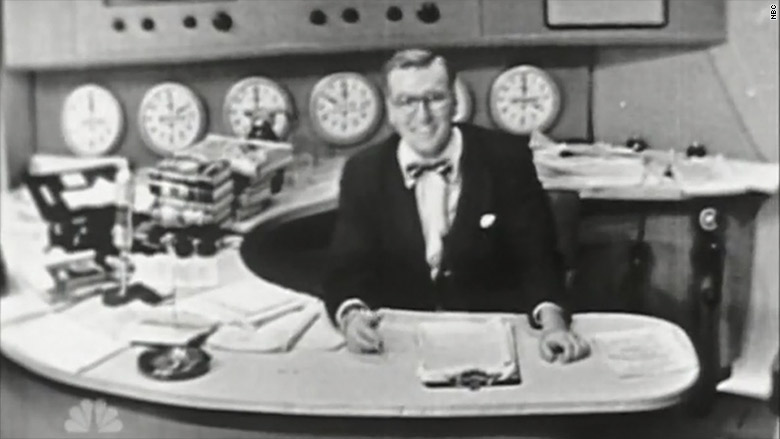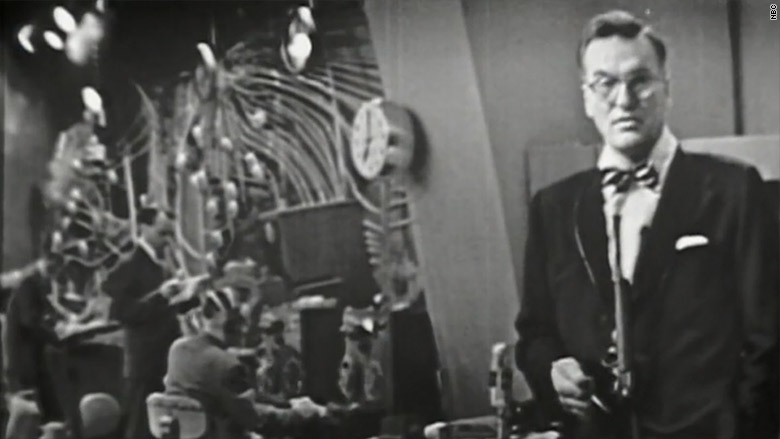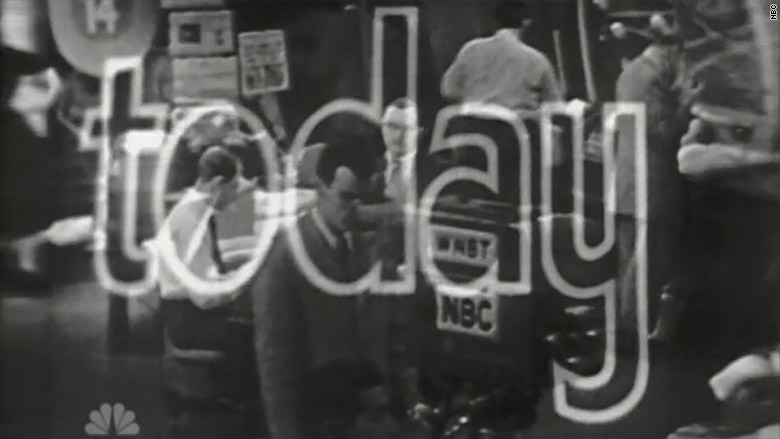
January 14 is the 65th birthday of NBC's "Today" show. This is a "lost chapter" from Brian Stelter's book "Top of the Morning," recounting how NBC invented the morning TV format.
Morning television in the United States flickered to life with these words:
"Today, January 14th, 1952. 7 a.m. Eastern standard time."
An oversized television camera marked "NBC" panned across a room of men (and a few women) answering phones and writing on typewriters. The word "Today" was superimposed over the camera shot. Somewhere out of sight, an announcer spoke:
"We are in NBC's world communications center in the heart of Radio City, New York. We are in touch with the world. We'll tell you what's happening today. My name is Jack Lescoulie."
Lescoulie paused for effect.
"And here is David Garroway."
Garroway, who was seated, looked up and smiled. The camera operator zoomed in on his face.
"Well here we are. And good morning to you. The very first good morning of what I hope and suspect will be a great many good mornings between you and I."

And with that, the "Today" show was born. Nowadays, television networks are always on, broadcasting 24 hours a day. But in 1952, this was a radical idea. There was no reason for families to turn on their newfangled TV sets in the morning... until NBC gave them a reason. This was a big deal because once they turned the TV set on in the morning, the set tended to stay on — a factor in the stunning rise in the amount of television consumption since.
Producer Sylvester "Pat" Weaver conceived of "Today" as an "electronic newspaper" at a time when broadcasting was beginning to rival printing.
Looking back, it's remarkable to see how many now-familiar features of morning television were baked in to the very first broadcast. A format you could set your watch by. A main man and his sidekicks, sharing personal details about themselves in between news segments. Live reports from far-flung cities. A weather segment with a map of the country.
"Every incarnation of morning television -- whether it be 'Today' or 'GMA' or 'CBS This Morning' or 'Morning Joe' -- is a derivative of what Pat Weaver invented in the 1950s," said Steve Friedman, who served two terms as executive producer of "Today" in the 1980s and 1990s.
Related from 2015: Matt Lauer and the restoration of 'Today'
Weaver truly was a pioneer. When television was in its infancy, he pushed for programs to have multiple advertising sponsors rather than just one, thereby giving networks, not sponsors, more control over programming. Weaver joined NBC -- then owned by David Sarnoff's RCA Corporation -- in 1949 and right away proposed a morning show. But, as he recounted in a 1994 autobiography, "we couldn't talk the network stations into opening that early." The stations typically only showed a test pattern at 7 a.m.
"There was an almost universal belief that no one would watch television right after they got out of bed," Weaver wrote.
But he believed otherwise, because so many families listened to the radio right after they woke up. Why not listen to the TV, then?
Weaver had worked at radio stations and had seen firsthand the huge audiences for morning shows like "The Breakfast Club" and "Breakfast in Hollywood." These were variety shows with gags and performances, but Weaver thought a news format would work just as well. In a memorandum dated July 19, 1951, almost exactly six months before the show's debut, he pitched "a morning communications show which will give the news, time, weather, tips for commuters and which will feature a rise-and-shine personality."
The tentative title was "Rise and Shine."
In another memo closer to the premiere date -- Weaver was notorious for his memo-writing -- he indicated that he wanted the new show to mimic radio, in that it would be a kind of background noise while listeners readied themselves for the day ahead. This premise -- that morning shows are heard as well as seen -- is now an article of faith among morning producers and hosts.
"We cannot and should not try to build a show that will make people sit down in front of their set and divert their attention to the screen," Weaver wrote. "We want America to shave, to eat, to dress, to get to work on time. But we also want America to be well informed, amused, to be lightened in spirit and in heart and to be reinforced in inner resolution through knowledge."
Note the word "amused" there. The show made sure to have a sense of humor. At first it was supplied in large part by Lescoulie, whose "frequently lighthearted tasks for 'Today' included wrestling a walrus, interviewing a penguin and eating six breakfasts in one sitting," The New York Times noted when he died in 1987. Lescoulie was the Willard Scott, the Al Roker of his time. But there was no doubt that the star of the show was Garroway.
A former NBC page, radio disc jockey and Chicago TV host, Garroway was in between jobs when he read in Daily Variety about Weaver's morning show idea. Garroway called his agent immediately. Bigger stars were being considered for the gig -- Bob Hope, Fred Allen, Milton Berle.
But Garroway was tenacious. "I was built to do this show," he said on the "Today" show in 1977 when the show celebrated its 25th birthday. "All my training had been as a generalist -- to specialize in nothing and to know something about everything. This show was made for me."
Garroway's audition impressed Weaver, who had always appreciated the host's casual style. (Garroway once said of his oft-cited casualness, "Nobody knows how hard I work to look that way.") Garroway won the job, which came with a $2,500 weekly salary. He signed a four-year lease for an apartment on Park Avenue, a confident move by a man whose last TV show was sidelined after two years. And a wise move, it turned out: Garroway was the host of "Today" for the next nine years.
Andy Lack, when he became president of NBC News in 1993, went back and watched what remained on tape of the original "Today" shows. He wanted to revisit what he called the "original recipe." He came away captivated by Garroway's authenticity and accessibility.
"Who would think of doing what he would do in those early shows?" Lack asked. "You can't make that up. That only comes out of a place deep inside a human being who has the imagination, the curiosity, the sense of humor, the intelligence, the passion, the thoughtfulness to engage what is in him and give it to you. You can't produce that. You can't package that. You've got to cast that."
Like Lack, Friedman was struck by Garroway's performance on the early "Today" show tapes. "He just talked to the audience -- he didn't read, he didn't yell, he didn't shout, he didn't gimmick, he just talked," Friedman said. "The people who are most successful in the morning are those that talk to the audience."
Related from 2015: NBC's 'Today' show savors a month of wins over 'GMA'
NBC built a "Today" show studio inside the RCA Exhibition Hall on West 49th Street and dubbed it "the nerve center of the planet." (See, television networks have been exaggerating for effect ever since the very start.)
Weaver situated the studio in front of floor-to-ceiling windows so that passersby could peer inside. (And so that "Today" could peer out. One day a staffer saw the former president Harry S. Truman watching through the windows and hurried outside for an impromptu interview on the street!)
Weaver, a master showman, told the staff in a pre-launch memo that he wanted them to produce "the finest news presentation in history." Television critics initially thought the show fell well short of that lofty goal; NBC should "roll over and go back to sleep." But Weaver was undeterred. He told Newsweek magazine that the launch of "Today" was nothing less than "a milestone in the social history of this country."
And he was right. "Today" is now one of America's best-known brands. It influenced not just consumption of television, but the consumption of household goods as well. Advertisers crafted new pitches for products like toothpaste and jams with the breakfast hour in mind; Garroway happily read them aloud on the air. Off the air, Garroway went a step further, visiting advertising agencies and selling them on the concept of "Today."
"Today" took viewers to new places, literally pointing cameras at sights never seen before on television and sometimes going on the road to faraway cities like Berlin and Paris. When like-minded morning shows started to pop up in other countries, "Today" was cited time and time again as inspiration. And, of course, the show inspired competition at home, from ABC's "Good Morning America" and a raft of others.
Related: the untold story of Good Morning America's creation
Garroway knew, on the very first day, that he was making history. In the first few minutes, he stood up to take viewers on a tour of this strange-looking newsroom.
"Here it is, as Jack said, January 14th, 1952, when NBC begins a new program called 'Today.' And if it doesn't sound too revolutionary, I really believe it begins a new kind of television. We'll be with you every day, for two hours in the morning, just about the time you get up, 7 to 9 a.m. We're going to try very much to put you more closely in touch with the world we live in."
He pointed across the studio to what he called the "magnificent, unparalleled means of communication which NBC has assembled into a single room in New York."
"We call this room our communications center," he explained. "From it, we'll put you in touch with the whole world."

Garroway, bow-tied and bespectacled, was called a "communicator," not a host. He pledged that this new "Today" show would cover the news "as no program ever has been able to cover before, because they didn't have this many tools," but it would also cover music, science, sports -- "all fields of human endeavor." Thanks to "Today," he said, viewers would now leave the house "knowing where you're going and what the world is like that you're going into."
"That sounds like a pretty big job; believe me, it is," Garroway said, allowing himself a moment to boast. "We've been working on this for quite a while. We're glad finally to have made the grade into your home for the first day. We hope we can give you enough to stay with you for a long time."
Garroway clasped his hands, rubbed them together and got on with the show. "That's a preamble; you know how preambles are, mostly talk; I'd like to get going and put you in touch today with the world that you're going to live in."
With that, he began a segment called "Today in Two Minutes," a news whip that he would repeat every half an hour for viewers just tuning in.
The time, 7:02 a.m., was imprinted in the lower right hand corner of the screen next to a scrolling ticker of newspaper headlines.
Eager to show off NBC's technological toys, Garroway walked over to a colleague who was pulling still-wet photographs off the telephoto machine.
He checked in with a reporter at the Pentagon and another one in Chicago and another one at Grand Central Station in New York City, where, viewers learned, "a train arrives every 47 seconds" at rush hour.
But a train arriving on time isn't really news. And unfortunately for NBC, on the first day of "Today," there wasn't much real news to cover.
"The top story," the news announcer James Fleming told viewers, was that "the White House will not re-submit the nomination of General Mark Clark as envoy to the Vatican." Then he reported on a recall of inflammable sweaters.
Later, Fleming read from the front pages of newspapers flown in and wired in from far corners of the country, just because he could. Lescoulie walked over to the wall of newspapers and watched with awe. "This is one of the most terrific things I've ever run into," he told Fleming. "I mean, the San Francisco Chronicle, 3,000 miles away, and we've got it in studio here!"
Though large swaths of the United States couldn't watch "Today" -- many families didn't own TVs yet, and some that did weren't within antenna range of the 14 NBC stations that carried the show on the first day -- Garroway treated the new show as a communal experience. Holding a telephone to his ear, he relayed the national weather report from a forecaster and scrawled the information on a chalkboard map of the country.
Maybe because of the intimate time of day, or maybe because he had two hours of air time to fill, Garroway spent some time introducing Lescoulie, who would go on to cover sports and news for "Today" for the better part of 15 years. Lescoulie talked about his days as an actor and his days as a combat reporter during World War II.
"I don't think that NBC picked me for any of these things," he said, suppressing a smile. "I think they were looking for a man who doesn't sleep well in the morning." He let out the smile while Garroway looked into the camera and added, "That has been a prime qualification for this job for all of us, by the way."
At 8:59 a.m., as "Today" ended on the East Coast, Garroway held his palm up in a gesture that he'd become famous for. "Until tomorrow morning," he said, "peace."


